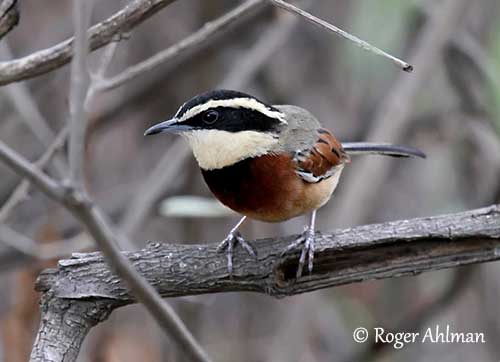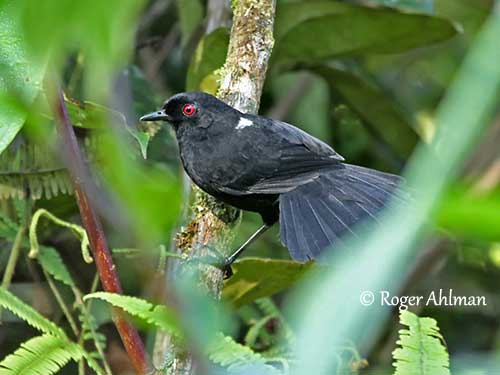
TO BE CONTINUED... Page 5 : Tyrannidae - Article already present on the website
New Page: Page 6
Text by Nicole Bouglouan
Photographers:
Roger Ahlman
Pbase Galleries Peru and Ecuador
John Anderson
John Anderson Photo Galleries
Didier Buysse
Vision d’Oiseaux
Jean Michel Fenerole
Photos d’Oiseaux du monde
Steve Garvie
RAINBIRDER Photo galleries & Flickr Rainbirder
Ken Havard
My Bird Gallery & Flickr gallery 1 & Flickr gallery 2
William Price
PBase-tereksandpiper & Flickr William Price
Dubi Shapiro
Dubi Shapiro Photo Galleries
Philippe et Aline Wolfer
OISEAUX D'ARGENTINE
These images and the text are subject to copyright and cannot be used without express authorization from the owners. Legal issues
Sources:
HANDBOOK OF THE BIRDS OF THE WORLD Vol 8 By Josep del Hoyo-Andrew Elliott-David Christie - Lynx Edicions - ISBN: 8487334504
BIRDS OF SOUTH AMERICA – Passerines - by Robert S. Ridgely and Guy Tudor – HELM Field Guides – ISBN: 9781408113424
A GUIDE TO THE BIRDS OF MEXICO AND NORTHERN CENTRAL AMERICA by Steve N. G. Howell, Sophie Webb - Oxford University Press - ISBN: 0198540124
A GUIDE TO THE BIRDS OF COLOMBIA by Steven L. Hilty and William L. Brown - Princeton University Press – ISBN 069108372X
Wikipedia, the free encyclopaedia
CREAGUS@Monterey Bay (Don Roberson)
Fatbirder - Melanopareiidae – Crescent-chests
The bird and its nest, where everything starts…
Second part: The Passerines – Order Passeriformes
Page 4: Thamnophilidae, Formicariidae, Grallariidae, Conopophagidae, Rhinocryptidae and Melanopareiidae
At the beginning of the breeding season and following several courtship displays, the nest-site is selected by the pair, or one of the members of the pair, and the nest is built within this area. For numerous species, the nest is the place where displays and copulation occur. It plays a very important role during the nesting period. It is the cradle of the chicks, the place where the adults feed them prior to their first flight towards independence.
The family Thamnophilidae includes antbirds, antwrens, antshrikes, antvireos, fire-eyes and bare-eyes. They are found in subtropical and tropical Central and South America, from Mexico to Argentina. They can be found in forested and scrubby habitats, and especially in humid lowland rainforests. Some species (less than 10%) may occur at higher elevations, up to 2,000 metres. Most of them are found in the Amazon basin across Brazil, Colombia, Bolivia and Peru.

These fairly small birds usually have short, rounded wings, well adapted to their life in the dense forest undergrowth. They have strong, large legs allowing them to grip vertical stems, whereas claws and tarsus length differ between species, according to their foraging behaviour.
The bill is often large and heavy. Numerous antshrikes have a hooked tip to the bill, but the antbirds have mostly a “tooth” at tip to hold and crush insects.
The plumage of most Thamnophilidae ranges mainly between blackish and whitish shades, grey, rufous, chestnut and brown colours. Male and female commonly show sexual dimorphism with different pattern and colouring.
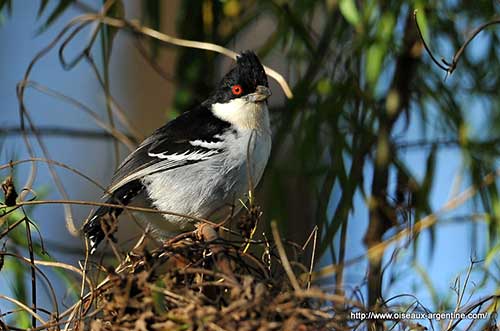
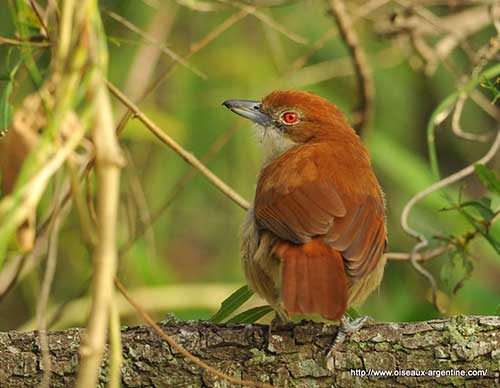
Great Antshrike
Male
Great Antshrike
Female
The Thamnophilidae are diurnal and roost within the dense foliage, rarely emerging into the open. They feed primarily on arthropods and insect larvae. The larger species may eat snails and small vertebrates, and also bird’s eggs.
They may sometimes feed on plant matter such as fruit and berries. They regurgitate the hardest part of the food items.
Prey are taken by gleaning, or short fluttery sally to the vegetation, or from a perch and then, grabbing it with the bill. The larger prey may be beaten against a branch before to be eaten, and wings and spines are often removed.
Many species are arboreal and feed in the understorey, the middle storey and some of them in the canopy and a few in the leaf litter.
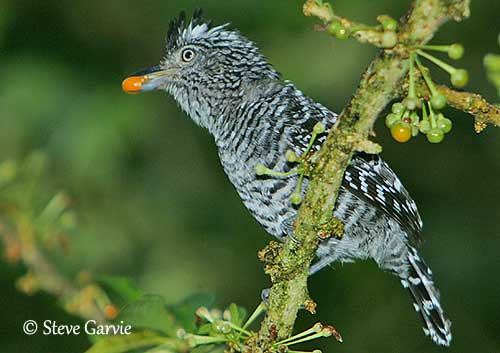
The members of the family Thamnophilidae are monogamous with long-term pair-bonds. Courtship feeding is common prior to copulation. Some species also perform mutual grooming.
However, divorces may occur between mates, such as in the White-plumed Antbird, but this behaviour is exceptional. The territory is defended by the pair of most species.
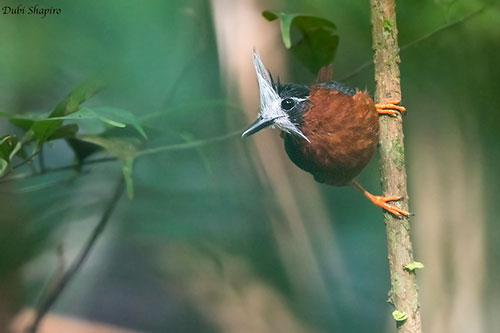
The Ocellated Antbird has special social system: the breeding pair forms the nucleus of a group that includes their male offspring and their mates, involving groups of up to eight birds defending together the territories against rivals.
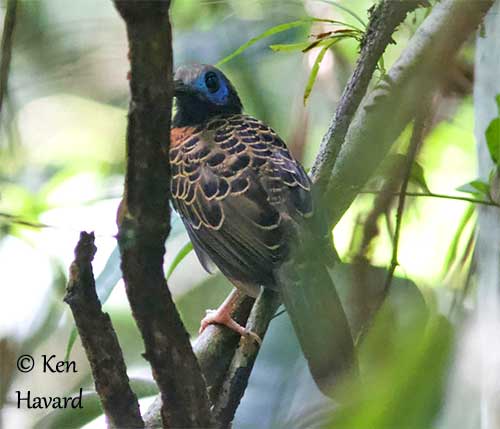
Both mates build the nest together, and additional material is often added during the incubation. Two nest types can be found: the suspended nests and the supported nests. The most common type is a suspended open cup made with vegetable matter including grasses, twigs, dead leaves and plant filaments. The cup is usually lined with a blackish fungus (Marasmius) that resembles horsehair. These open cups are often suspended by the rim from a horizontal fork in the outer branches of tree or shrub. Some nests are sometimes decorated with dead leaves or moss, with a dangling tail that can be very long below the cup.
Other suspended nests are more purse-shaped than cup-shaped. It is a deep, pensile pouch with oblique opening near the top. The thick walls are made with dead leaves, plant fibres, dead grass blades and strips of palm fronds. Such nests are suspended from the fork of a drooping tree branch, vine or climbing fern.
The nest of the Stipple-throated Antwren is very similar to the previous, but it is often more dome-shaped or oven-shaped with a side entrance. It is made with large dead leaves interwoven by strips of palm leaves and rootlets.
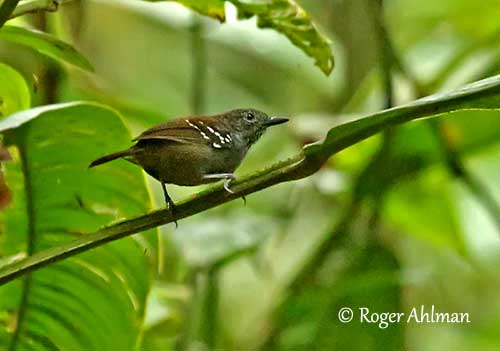
Stipple-throated Antwren
Other nests are built atop substrates, and supports are often branches in trees or hollows in dead stumps or natural cavities in live trees. But clump of sedge, root tangles and leaf litter on the ground are also used as support.
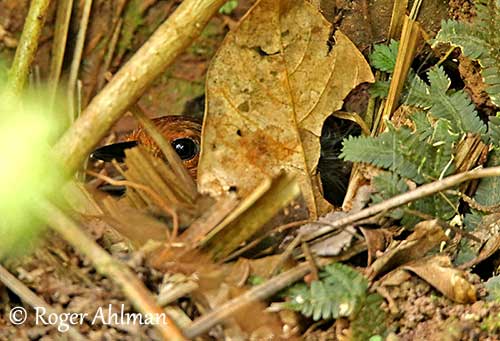
Scale-backed Antbird
Female at nest
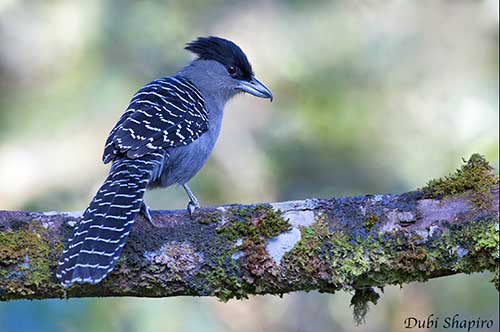
The Cinereous Antshrike builds a deep, leafy cup with dried rotten leaves, rhizomorphs and fine rootlets and lined with plant fibres and finer dried leaves. It is very similar to a pile of dead leaves.
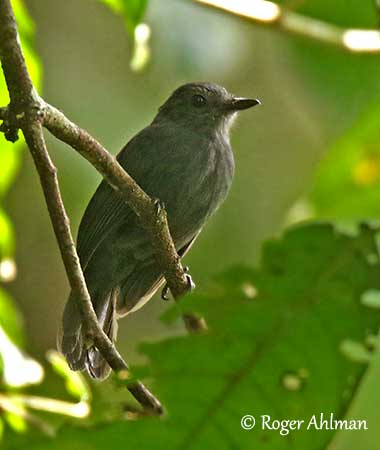
The White-plumed Antbird builds a cup-nest deep in debris on the growing tops of small palm trees, but also among sedges and herbs just off the ground.
All these examples may suggest that the Tamnophilidae are flexible and opportunistic in both type and location of the used space.
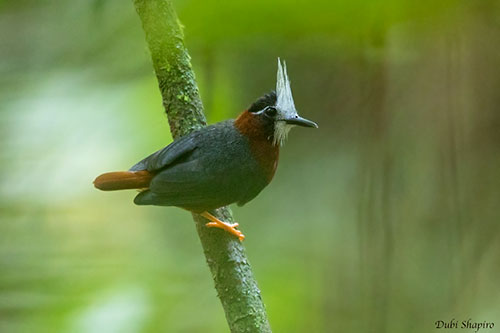
For almost all antbird species, the clutch contains two eggs, occasionally three in the southernmost part of the range, or only one for some species. The eggs vary from white to pale pink or buff, and show variable amount of darker markings.
Both adults develop brood patches and share the incubation that lasts 14 to 16 days, probably a few days longer in larger species. At hatching, the chicks are blind, naked and helpless, with pink to black skin colour.
The nestling period varies depending on the species, but it is suspected to be relatively short, from 8-9 days to 13-15 days. Both parents feed, protect and defend the chicks. The young birds remain quiet for several days after leaving the nest, remaining in the dense cover during the first days. Both parents accompany the juveniles until they are able to fly, and even after, but this period depends on each species.
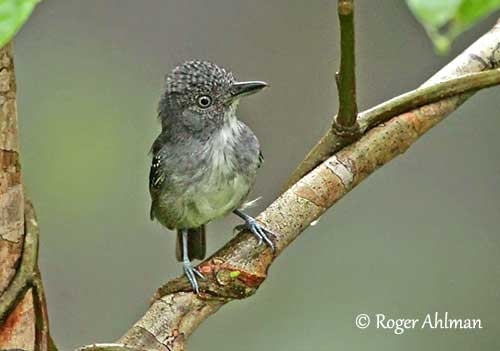
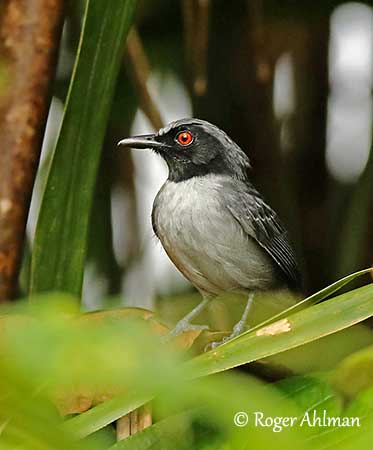
The family Formicariidae is that of the antthrushes of genera Formicarius and Chamaeza.
These birds can be found in Central America and the northern half of South America. They are forest birds and inhabit humid, wet and dry forest, according to the species. They usually forage and feed on insects on or near the ground.
They often have dull appearance, with plumages varying from rufous and brown to grey and black. They have small heads, long legs and chunky bodies, rounded wings and short tail.
The tail is usually cocked. This behaviour makes them very similar to a small rooster, and their Spanish name is “gallito” meaning “small rooster”. But actually, they look more like rails.
The long legs indicate that these birds prefer to walk on the forest floor, rather than fly in open space.
Male and female are similar.
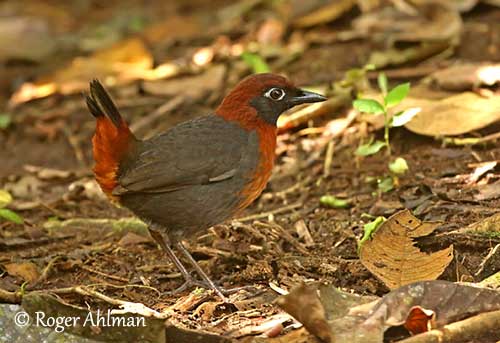
The Chamaeza antthrushes differ from Formicarius by the plumage pattern. They usually have barred underparts, shorter bills and paler legs, whereas the members of genus Formicarius have more uniform plumage colour.
They are known for their long, beautiful songs that can be heard through the Neotropical forest. The Barred Antthrush is one that never produces chuckle at the end of the song!
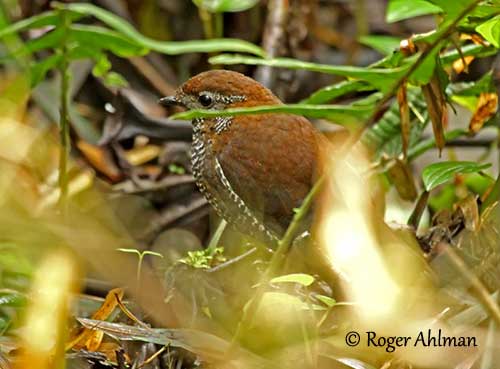
The Rufous-capped Antthrush lives in dense habitat in which the birds communicate by loud, deep songs, singing from low perches while stretching the head forwards.
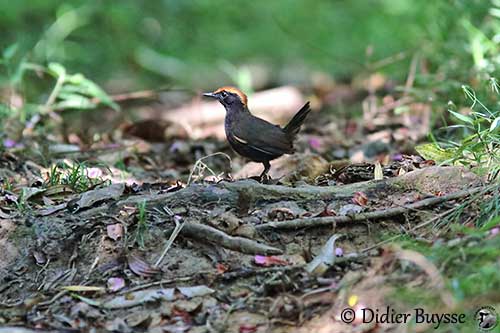
Both genera may feed sometimes on the fringes of swarms of army ants, but they usually feed alone or in pairs. They forage on the ground by walking slowly while flipping leaves as they are progressing. They feed primarily on invertebrates, but Formicarius species may sometimes eat small snakes. Fruits are also taken.
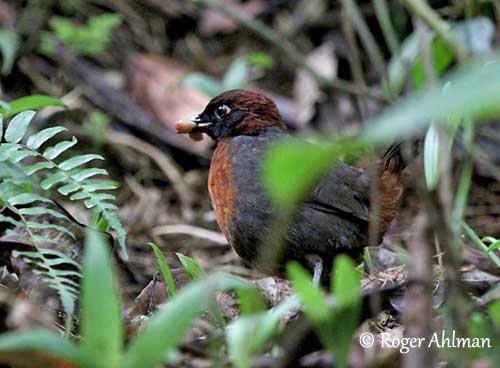
The breeding habits are poorly known, due to the secretive behaviour of these birds.
The antthrushes of genus Formicarius build a nest in a cavity, sometimes a hole abandoned by another species.
They usually build a cup-shaped structure in hollow trunk or stump. It is often made with leaf petioles and flower stalks on a pad of coarse dead leaves. It is usually placed far down inside the trunk or the stump. From an observation, a nest was found 35 centimetres below the ground inside a hollow trunk.
The clutch contains two white eggs that quickly acquire speckles and stains. Both parents incubate.
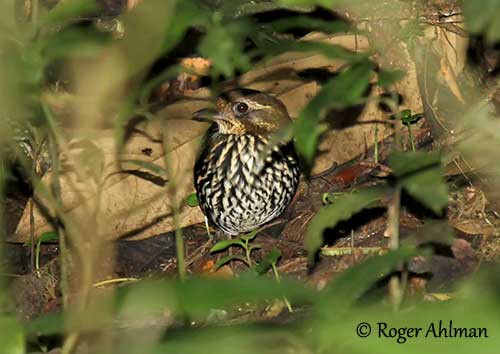
The antthrushes of genus Chamaeza are less known. The Short-tailed Antthrush builds the nest up to 2 metres above the ground in crevice in bank or in rotten stump.
The Striated Antthrush builds its nest in a cavity up to 3 metres above the ground in a live tree, a cavity 30 centimetres deep with no lining but only some feathers.
The clutch also contains two white eggs, sometimes more glossy than Formicarius eggs.
Both Formicarius and Chamaeza antthrushes are not globally threatened and occur in several protected areas throughout their respective ranges. However, habitat loss is the main threat for all species.
The family Grallariidae includes four genera, with a large one, Grallaria, and three smaller genera, Hylopezus, Myrmothera and Grallaricula. The two species of genus Pittasoma are genetically closest to the Gnateaters in the Conopophagidae family and are now assigned to this family.
All these species were formerly part of the previous studied Formicariidae family, but DNA-sequence data and morphological characters were enough for a new family to be created.
These species are found in subtropical and tropical Central America and South America and are named “antpittas”. However, they are not related to the Old World pittas of Pittidae family from which they derive their name.
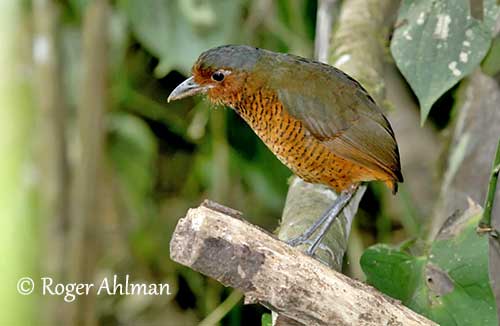
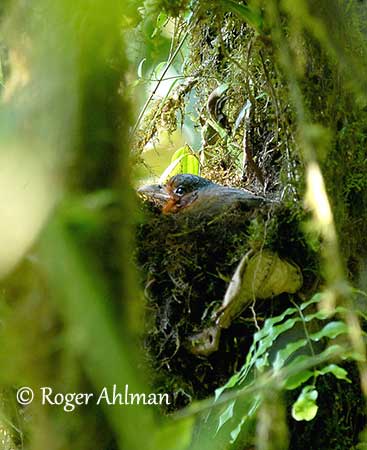
They are small to medium-sized birds. They have stocky body, long legs and very short tail. But the members of genus Grallaria like the Giant Antpitta are larger. They usually have dull-coloured plumage with rusty, brown, black and white dominant tones, but the underparts often show streaked or barred pattern on a brighter ground colour.
They are rather vocal, but often difficult to observe. They are found in forest were they feed on insects, on or near the ground. Fruits and berries are also taken, especially by the Peruvian Antpitta and the Pale-billed Antpitta.
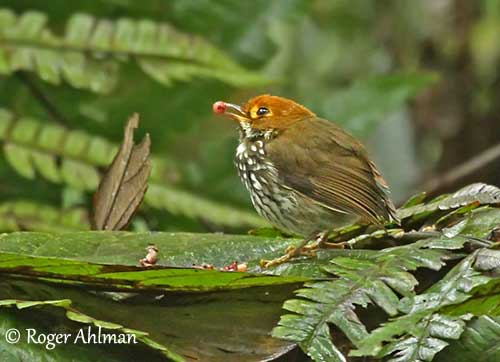
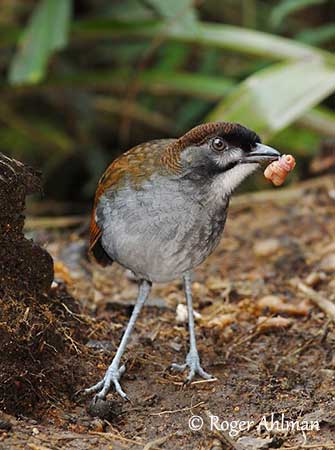
Their long legs are adapted to this foraging behaviour. They often feed alone or in pairs, and both mates communicate by sounds while searching for prey. They forage by walking on the forest floor, stop to scan the surroundings, and once a prey is located, they run to catch it. They usually adopt a distinctive upright posture, mainly due to these long legs and the very short tail.
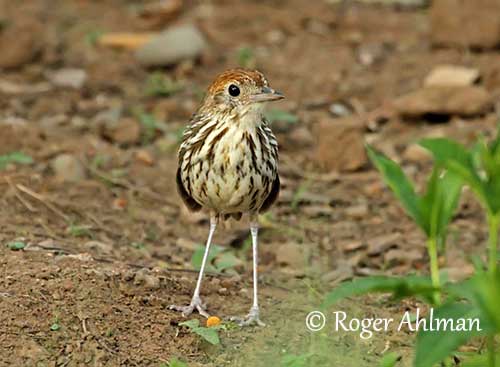
The breeding behaviour of these secretive birds is poorly known and few nests have been found and described. Many nests are only a simple, shallow cup with a thin lining of roots, petioles, plant fibres and some leaves. All these materials are placed upon dead leaves or moss, usually in tree. The normal clutch generally contains two eggs and both adults share the nesting duties.
The Pale-billed Antpitta uses this type of structure built on a sloping trunk at about 1,50 metre above the ground. The Jocotoco Antpitta builds a bulky cup supported by a large clump of epiphytes on dead tree trunk, about 3-6 metres above the ground.
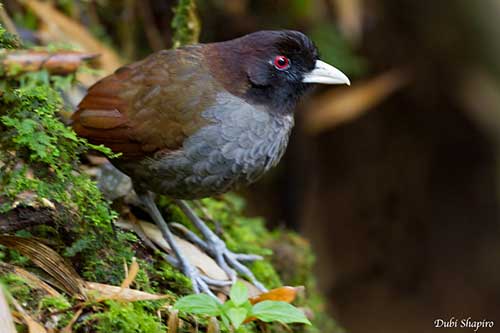
From an observation, the Streak-chested Antpitta may occasionally use an abandoned nest of other species. This habit has not been confirmed for any other member of this family.
The Giant Antpitta’s nest is a bulky cup of moss, built on top of thick tangle of fine vines anchored to the trunk of a thin tree, at about 7 metres above the ground. The nest-site is in humid montane cloud forest with dense understorey, at around 15 metres from a stream.
The incubation was underway in late December. Two eggs uniformly turquoise were in the nest. The incubation period was roughly estimated at 11-18 days. Both adults share the incubation, while arranging the nest-materials.
These species are threatened by deforestation involving habitat destruction. Several species are more or less threatened and their habitat needs many additional protected areas.
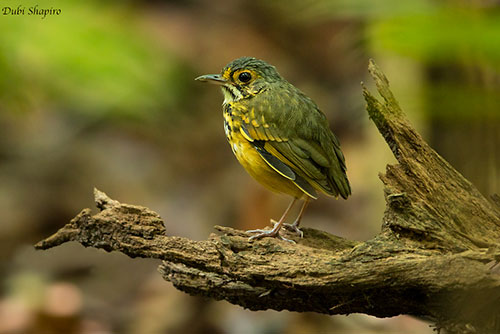
The family Conopophagidae includes two genera: the gnateaters of genus Conopophaga and the two antpittas of genus Pittasoma.
The gnateaters are found in Amazon and Orinoco basins, also on east and central Andean slopes, in the Atlantic Forest and nearby areas. They frequent the humid understory and are often near the forest floor, usually less than 1,5 metre above the ground. They occur at different elevations, depending on the species.
These small birds have plump body, short-tail and long-legs. Like antpittas, they adopt an upright posture when standing. There is a white tuft behind the eye, visible in almost all the species. They are sexually dimorphic with numerous variations.
The Black-cheeked Gnateater is the only species that does not show pale postocular tufts, but some males may exhibit 2-3 white feathers behind the eye.
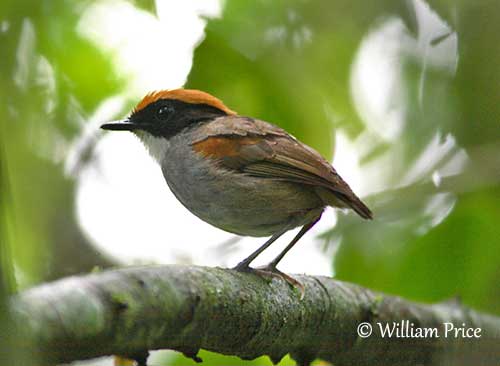
They are insect-eaters, giving the group its name. They primarily feed on insect larvae, caterpillars, grasshoppers and beetles, and also spiders. Some fruits are probably occasionally taken.
They hunt using two methods. The bird perches above the ground while searching for prey. Once the prey is located, it launches down to the forest floor to catch it before returning quickly to a perch. They also glean insects from foliage, treetrunks, and branches of low vegetation. Some observations report gnateaters following swarms of army ants.
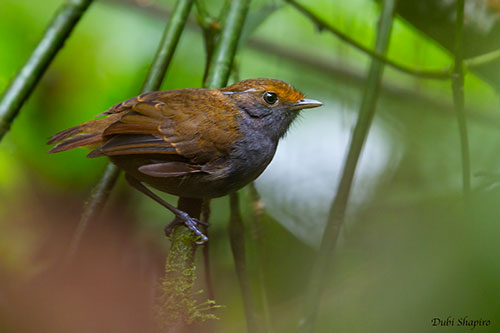
The gnateaters are suspected to be monogamous, as they are found in pairs all year round. Few nests have been recorded, but they appear fairly uniform both in architecture and placement.
The birds build a shallow cup supported by thin branches of a sapling. They are less often placed among herbaceous plants. Large leaves, both dead and fresh leaves, are used as camouflage, and some protruding twigs can be seen around the rim. The appearance is that of a flattened structure or a pile of debris atop of small plants. Cup, edges and rim are largely made with wiry, blackish rootlets or lichens.
The nests are usually built between 15 centimetres and 2 metres above the ground, but no nests have been found directly on the ground.
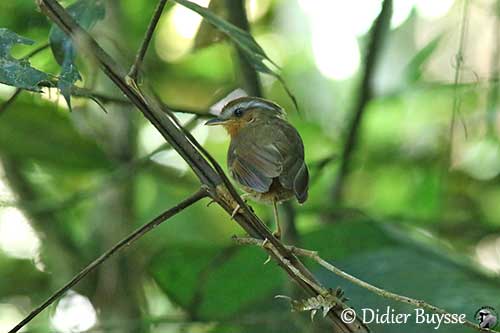
The clutch size appears to be two eggs, often rusty, buffy, yellowish or cream-coloured with darker markings around the larger end. The incubating bird takes advantage of the camouflage of the nest and does not flush when an intruder approaches. It leaves the nest only when it is at about 5 centimetres, flushing to the ground where it performs distraction display, often the “broken wing” display. Both parents share the nesting duties.
The gnateaters are relatively common in suitable habitat and they are not globally threatened. But the deforestation may be a problem in the future, involving fragmentation of the habitat.
The Chestnut-belted Gnateater is known to be one of the first species to disappear after fragmentation of the forest.
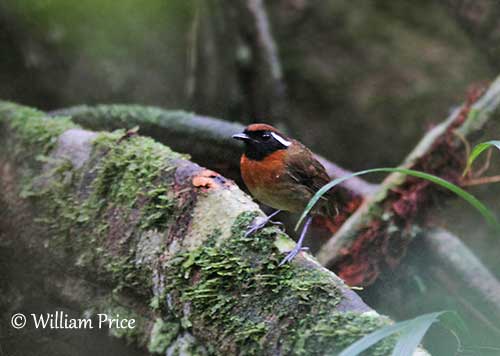
The two antpittas of genus Pittasoma were reclassified to Conopophagidae following several analysis such as DNA-sequence data, and also for their morphological characters. They are genetically closest to the Gnateaters in the Conopophagidae family and are now assigned to this family. The genus includes the Rufous-crowned Antpitta and the Black-crowned Antpitta.
They occur in the Chocó, and also in Panama and Costa Rica. They frequent humid-wet forest, usually on or near the ground and in the shady parts. They are present from lowlands up to 1,000 metres of elevation.

They are the largest members of the family Conopophagidae. They are round and short-tailed with long legs. They have long, straight bills. Male and female differ in plumage, but the sexual dimorphism is less pronounced than in genus Conopophaga.
Like the gnateaters, they adopt an upright posture when standing on the ground. These features indicate terrestrial habits.
Their diet is poorly known, although they have been observed following swarms of army ants. They are probably insectivorous. They usually forage alone or in pairs, commonly hopping and bounding on the forest floor, with pauses during which they may remain motionless for long periods.
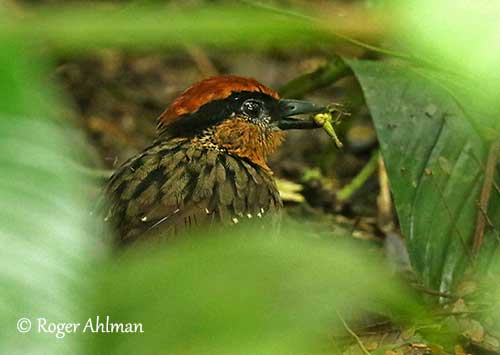
Their breeding behaviour is unknown. Only one nest has been found and described. It was a cup-shaped structure with thin walls made with fine, dark rootlets supported by a thin bed of dead leaves. The nest was built 1 metre above the ground, in the crown of a low palm species. The clutch apparently contains two eggs.
The members of genus Pittasoma are not globally threatened and occur in protected areas, but the deforestation remains a major problem for these birds as both are restricted-range species.
The Rufous-crowned Antpitta is restricted to humid forests where it shares its range with an important human population involving destruction and degradation of the habitat. This species is listed as Near Threatened.
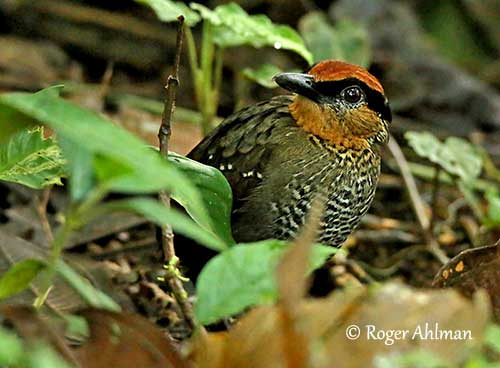
The members of the family Rhinocryptidae are mainly found in South America, especially in the Andean regions, and three species occur in Central America. They are known as Tapaculos. Their closest relatives are the Conopophagidae and the Formicariidae (see above).
They frequent bamboo thickets and dense mossy understory of remnant of cloud forests, where they forage on the ground and low down in the dense vegetation, like mice.
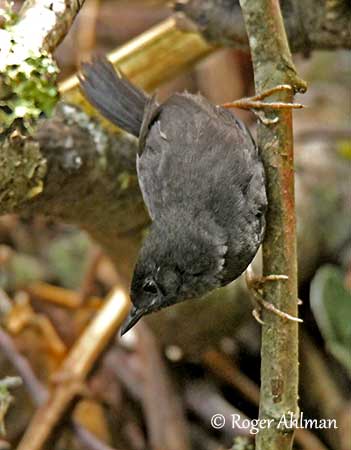
Some species such as the Mustached Turca are found in semi-humid/arid areas. The Ocellated Tapaculo is mainly found in bamboo thickets, whereas the Spotted Bamboowren prefers large stands of bamboo at the edge of the dense secondary forest in SE Brazil. Most species of genus Scytalopus are ground dwellers and frequents forest understorey, tussock grass and rocky boulders, while others can be found in bushy patches and Polylepis woodland at the treeline.
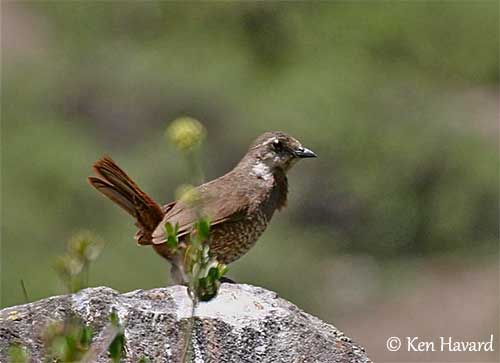
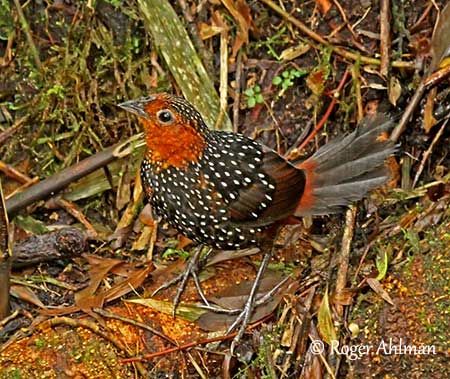
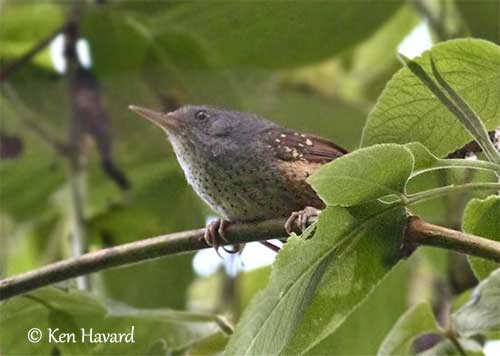
Tapaculos are small to medium-sized birds with long, strong legs, and powerful feet with large claws, indicating their terrestrial habits. The short-rounded wings do not allow sustained flight. The graduated tail is usually cocked in wren-like fashion, and even sometimes held forwards and almost touching the head. The bill is rather straight, weak and slender, sometimes with elevated base to add some strength. Most of them have mainly brown or blackish plumage, although some species may have more colourful appearance.
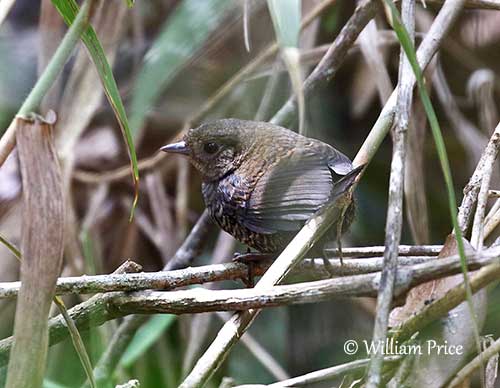
Tapaculos are generally hard to see in their dense, dark habitat, but their loud, penetrating songs can be easily heard through the dense vegetation as the birds often sing from exposed perch. They are usually found in pairs, with both mates foraging together while keeping a vocal contact.
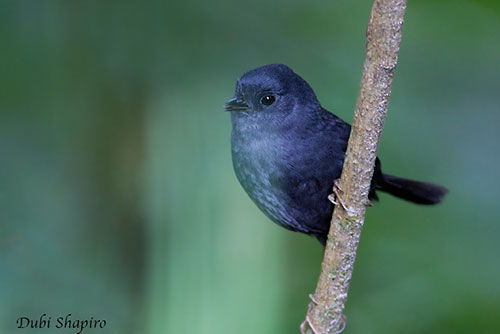
They feed on arthropods such as insects and spiders, but other small invertebrates, and also seed and berries are probably part of their diet.
The feeding behaviour is described only from some brief observations. The bird walks or runs quickly, stopping and scraping the ground with one foot or with both feet, throwing earth and leaves backwards while slowly working its way into the ground.

The tapaculos of genus Scytalopus glean food items from moss, leaf litter, earth or rotting vegetation while moving along on the ground in the undergrowth. However, the two bristlefront species dig with the head into the leaf litter, probably thanks to their elongated loral feathers that help their vision.
All species are mainly terrestrial and often appear mouse-like while foraging quickly on the ground.
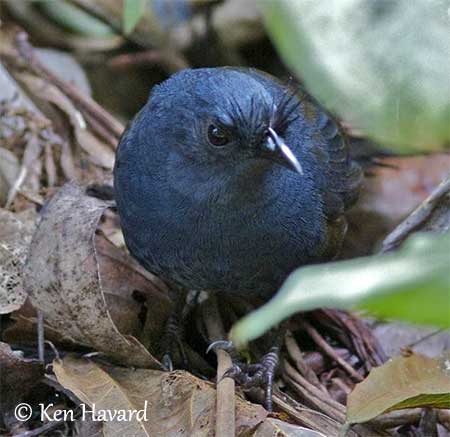
The nesting behaviour of these birds is poorly known, due to their secretive habits within their dense habitat. Only less than twenty nests have been described, and they show considerable differences depending on the genera.
However, all these nests were made with root fibres, grass, moss and some small twigs.
Most species use a covered location such as a burrow, a tree hole or they build a domed nest. Most tapaculo nests are situated at the end of a burrow under the ground, among roots or in rotten stumps. They generally excavate the tunnel themselves, even in hard ground mike the Mustached Turca does, but other species may use abandoned rodent burrows.
The Black-throated Huet-huet and the Chestnut-throated Huet-huet dig their burrows, but they also may use hollow trunks, with an observation of a nest placed 17 metres above the ground ! But generally, the nests are mainly less than two metres above the ground.
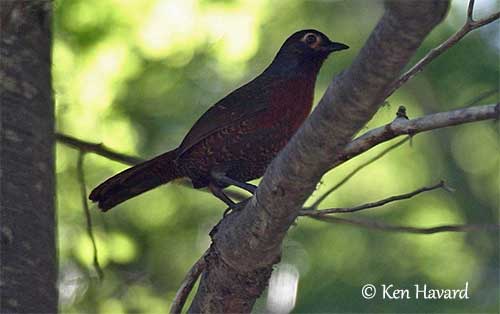
The eggs of tapaculos are white, as usual in cavity-nester species. Some species such as the Ochre-flanked Tapaculo and the White-breasted Tapaculo, produce two clutches per year, and the Slaty Bristlefront only one. Nothing is known about the other species. The incubation period lasts two weeks in the White-breasted Tapaculo and 16-17 days in the Crested Gallito. In both species, both parents share the nesting duties. However, only the females of the north Andean species of genus Scytalopus have a brood patch. The chicks are reared by both adults in most species.
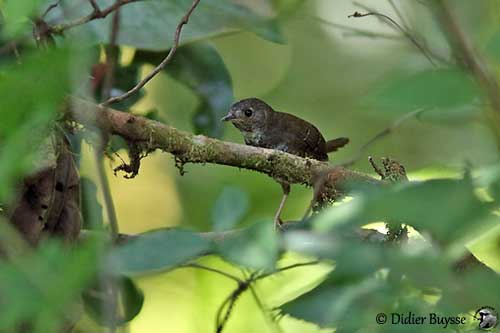
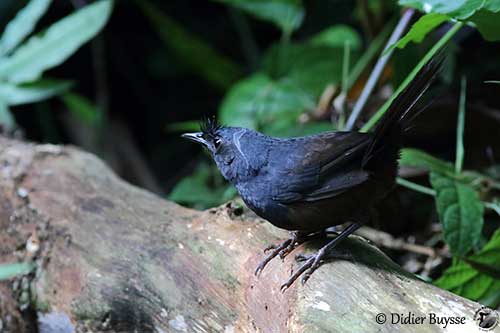
The Rhinocryptidae are threatened by habitat destruction with heavy deforestation in many regions and destruction of rushy marshes in E Panama. They often live in restricted range, making them globally threatened at different levels, according to the species.
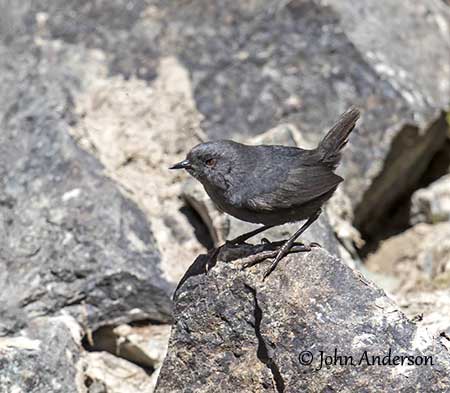
The family Melanopareiidae includes five species that were formerly part of the Rhinocryptidae family (see above). Two species, the Marañón Crescentchest and the Elegant Crescentchest are locally found in the arid country of coastal Ecuador and Peru, whereas the Collared Crescentchest and the Olive-crowned Crescentchest are mainly found southwards in Bolivia, Brazil, Paraguay and N Argentina. The Double-collared Crescentchest was formerly a subspecies of the Collared Crescentchest, but it is now a full species found in E Bolivia and SW Brazil.
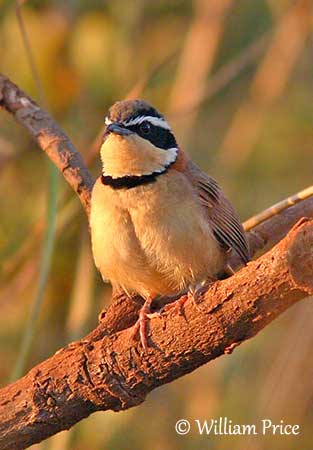
The crescentchests are more colourful and strikingly marked than the Rhinocryptidae species. They have a conspicuous black band across the breast, giving the birds their name. They are small with long tail and contrasting head pattern. The upperparts are brown to olive-brown and the underparts may vary from buff to tawny or rufous, depending on the species. The head pattern is almost similar in all species, with only some colour variations.

These birds usually frequent arid scrub with scattered low bushes from lowland to high elevations. The Olive-crowned Crescentchest can be seen up to 1,700/3,000 metres, the Elegant Crescentchest up to 2,400 metres in dry scrub and undergrowth of low, semi-arid woodland, and the Marañón Crescentchest between 200 and 750 metres. The Collared Crescentchest is present from lowlands to 1,000 metres in dry, hot regions where it frequents savannas and grasslands.
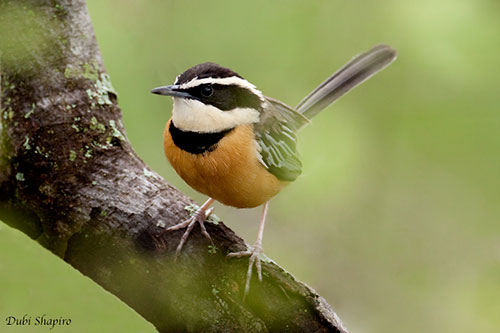
They forage on or near the ground by hopping, usually under dense cover. They move among clump of grasses, shrubs and trees, making them very difficult to find. The Collared Crescentchest feeds on insects, spiders and centipedes, and the other species probably have similar diet.
They can be seen alone or less commonly in pairs. The behaviour of the members of this family is very poorly known. They are probably sedentary.
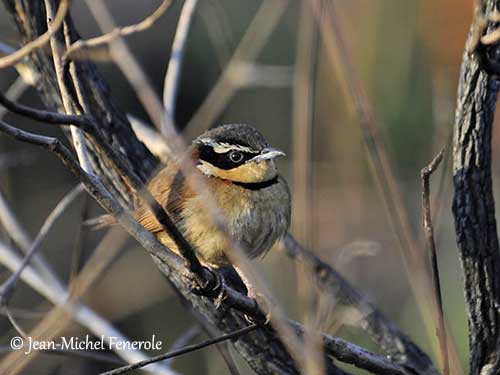
They are apparently monogamous and both mates defend the territory. Some details about the Olive-crowned Crescentchest indicate that this species is a seasonal breeder.
From an observation of three nests, these birds build a cup-shaped structure with plant fibres and palm fronds. The nest is hidden near the ground, in low shrubs or in tall grass. The third nest was a tunnel of 10 centimetres in length made with fine grass and lined with thicker grass. The clutch usually contains 2-3 white eggs with small dark markings.
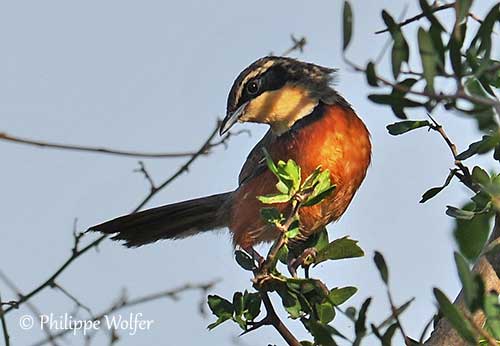
The crescentchests are not globally threatened, although the Marañón Crescentchest is listed as Near Threatened, due to destruction of its restricted range. The other species are uncommon to locally common, and are suspected to tolerate some disturbance. Except for the Marañón Crescentchest, they are probably present in several protected areas.
